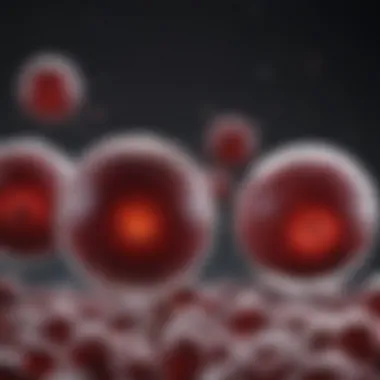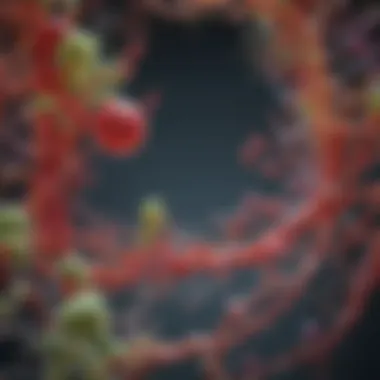Resveratrol Bioavailability: Unraveling Its Complexities


Intro
Resveratrol is a polyphenolic compound notable for its presence in grapes and certain berries. This compound has garnered considerable attention within health and wellness communities, primarily due to its potential health benefits. However, its bioavailability remains a critical aspect that influences these potential advantages. It's not just about consuming resveratrol; understanding how it is absorbed and utilized by the body is vital for elucidating its efficacy.
Studying the bioavailability of resveratrol involves examining a variety of factors, including its metabolism, absorption, and overall impact on human physiology. These elements determine how much of the compound enters the bloodstream and how it exerts its effects on various health conditions. This article seeks to present a comprehensive understanding of resveratrol bioavailability, addressing the complexities surrounding it, as well as discussing effective strategies to enhance its utility in therapeutic applications.
Intro to Resveratrol
Resveratrol is a compound that has garnered considerable attention in health and nutrition circles. Its relevance stems from its potential health benefits, particularly concerning cardiovascular health and its antioxidative properties. Understanding resveratrol is essential as its bioavailability largely dictates how effectively the body can utilize it.
When we refer to bioavailability, we are concerned with how much of a given compound enters the bloodstream and reaches systemic circulation. This is crucial for any supplements or nutrients, including resveratrol, as the concentration that is ultimately delivered to tissues can greatly influence its effects.
Given that resveratrol is often consumed through dietary sources, its absorption can fluctuate based on various factors. Thus, discussing resveratrol is not merely an exploration of its benefits but also an examination of how to maximize its effectiveness within the human body. This article aims to illuminate these complexities and discuss implications for health and wellness.
Defining Resveratrol
Resveratrol is a polyphenolic compound, characterized by its chemical structure that comprises multiple phenolic functional groups. It is primarily found in the skin of red grapes, although it is also present in other plants, such as berries, and nuts. These compounds are produced by plants as a response to environmental stressors or injuries, serving protective roles.
Biochemically, resveratrol can exist in various forms, including cis- and trans-isomers, with the trans-resveratrol form being the most studied due to its higher bioactivity. Preliminary research indicates it acts as an antioxidant, scavenging free radicals and thus possibly reducing oxidative stress.
Historical Context and Discovery
The discovery of resveratrol dates back to the 1940s when it was first isolated from the root of the plant Polygonum cuspidatum. Over the decades, its potential health benefits began to attract attention, particularly after the French Paradox was publicized in the 1980s. This term refers to the observation that French individuals often consume a diet high in saturated fats yet maintain relatively low heart disease rates, attributed in part to the moderate consumption of red wine containing resveratrol.
This observation catalyzed numerous studies, aiming to understand resveratrol’s role in cardiovascular health, ultimately characterizing it as a potential activator of cellular processes linked to longevity and metabolism.
Sources of Resveratrol
Resveratrol can be sourced from a variety of foods, making it accessible through dietary choices. Significant sources include:
- Red grapes: The most well-known source; resveratrol is particularly concentrated in the grape skin.
- Red wine: Contains resveratrol due to the fermentation process used in its production.
- Berries: Such as blueberries and cranberries also provide resveratrol albeit in smaller amounts.
- Peanuts: Another noteworthy food containing resveratrol, contributing to its dietary uptake.
- Dark chocolate: Contains flavonoids, including resveratrol, which may impart various health benefits.
While these sources are beneficial, the concentration of resveratrol varies widely. Therefore, one should consider the form and source when assessing dietary intake and potential health benefits.
Understanding Bioavailability
Bioavailability refers to the proportion of a substance that enters the systemic circulation when it is introduced into the body. This concept is critical for understanding how compounds like resveratrol perform in terms of health benefits. The bioavailability of resveratrol impacts its efficacy, making it essential to examine how it is absorbed, metabolized, and distributed. Poor bioavailability can limit the therapeutic potential of resveratrol, underscoring the importance of exploring ways to enhance it. By dissecting the elements of bioavailability, we can better appreciate the challenges and strategies related to resveratrol's utilization in health supplements and clinical applications.
Concept of Bioavailability
The concept of bioavailability is not just a technical term; it carries significant implications for how substances interact within our bodies. Understanding bioavailability allows researchers and healthcare professionals to evaluate the effectiveness of various compounds. For resveratrol, it offers insights into how much of this polyphenol can reach target tissues effectively. Factors such as chemical formulation and administration route are pivotal. This concept helps outline the limitations faced in dietary applications and supplements.
Components of Bioavailability
The components of bioavailability encompass three fundamental processes: absorption, metabolism, and distribution. Each component plays an integral role in determining how effectively a compound like resveratrol operates in the body.
Absorption
Absorption is the initial step in bioavailability and refers to how much of the compound enters the bloodstream after administration. For resveratrol, factors like solubility and the presence of other foods can influence absorption rates. The key characteristic of absorption is its potential variability amongst individuals, which poses challenges for standardization in health benefits. Moreover, the unique feature of absorption in the case of resveratrol includes the influence of simultaneous consumption of fats, which may enhance its uptake. However, this can also be a disadvantage when considering dietary recommendations, as it complicates guidelines for optimal intake.
Metabolism
Metabolism involves the transformation of resveratrol within the body after it is absorbed. This phase includes enzymatic processes that convert resveratrol into various metabolites. One critical aspect of metabolism is the activity of liver enzymes, which can significantly influence the bioactive forms of resveratrol available in circulation. The key characteristic of metabolism associated with resveratrol is its relatively rapid conversion, impacting how long the benefits last post-ingestion. The unique feature here is that while metabolism can deactivate some potentially beneficial effects, certain metabolites may display significant biological activity, adding to the complexity of its health implications.
Distribution


Distribution represents how the absorbed substances circulate throughout the body. Once resveratrol enters the bloodstream, it is distributed to various tissues and organs. This process is influenced by factors such as blood flow and cell membrane permeability. A significant aspect of distribution for resveratrol is its potential for selective accumulation in specific tissues, such as the brain. This characteristic makes it enticing for neurological health but poses questions about the advantages and disadvantages of this selectivity. For instance, while targeting specific tissues can enhance certain health benefits, it may simultaneously limit effects in other areas, affecting overall therapeutic utility.
Resveratrol's bioavailability is not just about absorption; it involves a combination of metabolic and distribution factors that determine its efficacy in health-related contexts.
Factors Influencing Resveratrol Bioavailability
Understanding resveratrol bioavailability is crucial to unlock its health potential. Several factors can either enhance or limit the absorption, metabolism, and distribution of this compound within the human body. A nuanced comprehension of these elements can provide insight for researchers and health enthusiasts alike. This section look into some of the key aspects that influence how effectively resveratrol manifests its benefits.
Chemical Structure
The chemical structure of resveratrol plays a significant role in its bioavailability. Its phenolic nature determines how well it interacts with other molecules. Resveratrol exists primarily in two forms: trans-resveratrol and cis-resveratrol. The trans form is often more stable and bioavailable. The presence of hydroxyl groups in its structure allows for potential binding with proteins and other compounds in the body, aiding its absorption but also influencing its metabolism through enzymatic pathways.
Formulation and Delivery Systems
Different formulations greatly impact the bioavailability of resveratrol. For instance, the type of delivery system used can affect stability and absorption rates. Solid formulations like powders might have lower absorption compared to liquid forms, such as suspensions or emulsions, which can enhance solubility. Liposomal formulations, which encapsulate resveratrol in lipid layers, also show promise in improving absorption. Hence, selecting the right formulation can optimize the therapeutic effects of resveratrol.
Dietary Interactions
Dietary components can interact with resveratrol, affecting its bioavailability. Consumption of fatty foods may enhance the absorption due to resveratrol's lipophilic nature. Conversely, certain fibers may bind to resveratrol, potentially reducing its availability in the intestine. Moreover, the presence of other polyphenols might either facilitate or inhibit the absorption of resveratrol. Taking resveratrol with a balanced meal may yield better uptake compared to fasting. Understanding these interactions can help in structuring effective dietary recommendations.
Physiological Variations
Physiological variations among individuals can significantly influence the bioavailability of resveratrol.
Age
Age affects metabolism and absorption rates of nutrients. Older adults often experience slower gastric emptying and altered enzyme activity. This slower digestion might hinder or delay absorption of resveratrol. However, older populations may also have a greater need for antioxidants, making resveratrol advantageous, but its lower absorption could limit effects.
Gender
Gender differences in metabolism can influence how resveratrol is processed in the body. For example, females may metabolize resveratrol differently than males. Estrogen fluctuations in women could alter the absorption rates, possibly increasing bioavailability during certain phases of the menstrual cycle. However, research remains limited, necessitating further exploration on how gender impacts resveratrol's health benefits.
Health Status
Overall health status plays a crucial role in how resveratrol is absorbed and utilized. Individuals with metabolic disorders or gastrointestinal issues may experience impaired absorption. Additionally, conditions like inflammation might affect the bioavailability of resveratrol. For those in better health, the effects of resveratrol may be more pronounced, making health status a vital consideration when studying its benefits.
In sum, recognizing these factors can pave the way for better utilization of resveratrol in dietary and therapeutic scenarios. Studies that focus on these aspects may lead to more tailored health recommendations.
Metabolism of Resveratrol
Understanding the metabolism of resveratrol is crucial for grasping its overall bioavailability and effectiveness in the human body. Metabolism refers to the biochemical processes that modify a compound, allowing for its elimination or enhanced functionality within the body. Resveratrol undergoes significant changes during metabolism, which can influence its therapeutic potential.
The complexities of its metabolism can affect how much of the compound is available for biological action after ingestion. This process primarily occurs through two phases: Phase I and Phase II metabolism.
Phase and Phase Metabolism
Phase I metabolism of resveratrol typically involves oxidation and reduction reactions. These reactions are catalyzed by enzymes, notably cytochrome P450. The products formed may become more water-soluble, preparing them for further processing. In Phase II metabolism, the compound undergoes conjugation. Here, the metabolites from Phase I are combined with other substances, such as glucuronic acid, to enhance solubility. This conjugation enables the body to excrete the compound more easily.
Some key points regarding Phase I and Phase II metabolism:
- Phase I Reactions: Initial changes that modify chemical structure.
- Phase II Reactions: Increase water solubility, facilitating excretion.
- Impact of genetic variations: Different individuals can have varying enzyme activities, which may lead to differences in metabolism.
Understanding these phases helps in comprehending reasons behind the poor bioavailability of resveratrol, despite its beneficial properties.
Impact on Pharmacokinetics
Pharmacokinetics involves the movement of drugs within the body, often described through various phases: absorption, distribution, metabolism, and excretion. Resveratrol's unique pharmacokinetic profile can significantly influence its health benefits.


- Absorption: After ingestion, resveratrol is rapidly absorbed, but its bioavailability may be limited due to extensive first-pass metabolism in the liver.
- Distribution: Once in the bloodstream, its distribution can be hindered by its rapid conjugation in the liver, impacting how effectively it reaches various tissues.
- Excretion: The Phase II metabolites are often excreted through urine, which can remove the active form of resveratrol before it exerts its full benefits.
The various pharmacokinetic behaviors underline the challenges in achieving therapeutic effectiveness through resveratrol supplements, requiring a focus on its metabolic pathway.
Understanding resveratrol's metabolism alongside its pharmacokinetics is vital for optimizing its potential health benefits. The knowledge can inform future research aimed at enhancing the compound's bioavailability and efficacy for therapeutic use.
Health Benefits Associated with Resveratrol
Resveratrol has gained significant attention due to its potential health benefits. Understanding these benefits is crucial to appreciate why research focuses on this compound. Resveratrol is acknowledged primarily for its role in promoting cardiovascular health, acting as a powerful antioxidant, and exhibiting anti-inflammatory properties. These aspects not only contribute to general wellness but also suggest possible applications in managing chronic diseases.
Its cardiovascular effects highlight one of the key ways resveratrol may protect heart health. Mechanisms such as improving endothelial function and reducing blood pressure are of particular interest. The antioxidant properties of resveratrol further enhance its value by combating oxidative stress. Lastly, its anti-inflammatory effects could contribute to managing various inflammatory conditions.
The following sections will delve deeper into these specific benefits to shed light on the significance of resveratrol in health and disease management.
Cardiovascular Effects
Research shows that resveratrol positively influences cardiovascular health. One of its primary functions is improving endothelial function, which is essential for maintaining the balance between vasodilation and vasoconstriction. This can directly affect blood flow and blood pressure.
Resveratrol may also help reduce levels of low-density lipoprotein (LDL) cholesterol, often referred to as "bad cholesterol." This action can lower the risk for atherosclerosis, a condition characterized by the buildup of plaque in the arteries.
Moreover, multiple studies suggest a correlation between resveratrol consumption and decreased incidence of heart disease. The compound promotes anti-inflammatory properties that reduce overall cardiovascular risks. The following points summarize its cardiovascular impacts:
- Improved endothelial function
- Reduced LDL cholesterol levels
- Lowered blood pressure
- Decreased inflammation in the cardiovascular system
Antioxidant Properties
Resveratrol is widely considered a potent antioxidant. This property is vital because antioxidants neutralize free radicals, which can damage cells and contribute to various health conditions, including cancer and aging.
The action of resveratrol on oxidative stress helps prevent cellular damage. Studies indicate that increased antioxidant activity can lead to better health outcomes. Resveratrol functions in various bodily processes to fight free radicals, offering the following benefits:
- Protecting against cellular damage
- Enhancing overall resilience to stress
- Supporting healthy aging
"Resveratrol is not just a compound; it's a promising agent in the quest for longevity and health resilience."
Anti-inflammatory Effects
The anti-inflammatory properties of resveratrol also deserve attention. Chronic inflammation is linked to many lifestyle-related diseases, such as obesity, diabetes, and even cancer. Resveratrol appears to modulate inflammatory pathways, reducing the production of pro-inflammatory cytokines. This modulation can alleviate symptoms and improve the quality of life for those suffering from inflammatory conditions.
Proactive management with resveratrol could have significant implications for treating chronic inflammatory diseases. Consider the following points:
- Reduction of pro-inflammatory cytokines
- Potential management of chronic diseases
- Improvement in symptoms of inflammatory conditions
In summary, the health benefits associated with resveratrol are profound and multifaceted. Its role in cardiovascular health, antioxidant capacity, and anti-inflammatory effects underscores its importance. As understanding deepens, future research may find even more ways to leverage these benefits in therapeutic practices.
Enhancement Strategies for Bioavailability
Enhancing the bioavailability of resveratrol is crucial to maximize its health benefits. Given that bioavailability directly affects how much of the compound enters systemic circulation and reaches target tissues, strategies need careful consideration. It is essential to understand the different enhancement strategies, as they play a significant role in both therapeutic contexts and general health applications. Without effective methods to improve its bioavailability, many individuals may not experience the full advantages attributed to resveratrol.
Nanotechnology Applications
Nanotechnology involves manipulating matter on an atomic, molecular, and supramolecular scale. This field has significant implications for enhancing the bioavailability of resveratrol. Nanocarriers, such as liposomes and nanoparticles, facilitate better absorption and distribution of resveratrol in the body.
Some of the benefits of using nanotechnology include:
- Improved solubility: Resveratrol is hydrophobic and often poorly soluble. Nanocarriers can enhance its dissolution in biological fluids.
- Sustained release: Nanotechnology allows for slower release profiles, prolonging the action of resveratrol in the bloodstream.
- Targeted delivery: This method enables resveratrol to be directed towards specific cells or tissues, increasing its effectiveness while minimizing side effects.


"The use of nanotechnology is one of the most promising strategies for improving the bioavailability of resveratrol."
Combination with Other Compounds
Combining resveratrol with other bioactive compounds can enhance its absorption and efficacy. For instance, pairing resveratrol with piperine, a compound found in black pepper, has demonstrated an increase in the absorption of resveratrol by inhibiting the enzymes that metabolize it. Other combinations might include vitamins or minerals, which can also facilitate a synergistic effect, enhancing benefits at the cellular level.
Key considerations when combining resveratrol with other compounds include:
- Synergistic effects: Certain compounds can enhance the properties of resveratrol, leading to more significant health outcomes.
- Safety and interactions: It is important to consider potential interactions that might diminish effectiveness or enhance adverse effects.
- Bioactive profiles: Understanding the pharmacokinetics of each component is necessary to ensure they do not counteract each other's benefits.
Dietary and Lifestyle Modifications
Dietary and lifestyle choices also play a role in how resveratrol is absorbed and utilized by the body. A healthy diet rich in fiber, proteins, and healthy fats can support gut health, which is crucial for nutrient absorption. For example, a Mediterranean diet, known for its high polyphenol content, may complement the effects of resveratrol.
Some practical modifications include:
- Regular exercise: Physical activity can enhance metabolic functions and improve circulation, potentially increasing the delivery of resveratrol to tissues.
- Avoiding alcohol: Since resveratrol is found in red wine, overconsumption of alcohol may inhibit its benefits. Moderation is key.
- Maintaining a balanced diet: Including a variety of fruits, vegetables, and whole grains supports overall health and gut flora, positively affecting absorption rates.
Clinical Studies and Trials
The exploration of resveratrol’s bioavailability cannot be complete without discussing clinical studies and trials. These studies provide invaluable insights into how this compound interacts within the human body, revealing potential health benefits as well as limitations. The clinical trials contribute to developing an evidence base that informs dietary recommendations, supplement formulations, and therapeutic applications. Such research is critical in understanding whether resveratrol can effectively support health claims made based on preclinical studies.
Overview of Key Research
A significant body of clinical research has been dedicated to assessing the bioavailability of resveratrol and its physiological effects. For instance, some studies have focused on the absorption levels of resveratrol when consumed via different sources, such as red wine versus concentrated supplements. Research has also investigated how various formulations affect its bioavailability, including lipid-based carriers or nanotechnology applications.
Moreover, key trials have analyzed resveratrol's impact on parameters such as cardiovascular health markers, inflammation levels, and antioxidant capacity. Notable studies often involve randomized controlled trials, providing robust data on its safety and therapeutic potential.
Outcomes and Implications
The outcomes of these studies are diverse but have significant implications for both the scientific community and the general public. Positive findings support the notion that resveratrol may contribute to health benefits, particularly in aging populations at risk of chronic diseases. However, the bioavailability challenges mean that is often difficult to achieve effective concentrations through dietary sources alone.
"Understanding the impacts of formulation and absorption is key to unlocking the potential of resveratrol as a therapeutic agent."
The implications also extend to lifestyle recommendations. Awareness of dietary interaction, for instance, educates individuals on maximizing the absorption of resveratrol from foods. Additionally, the results of clinical trials help to identify gaps in research, guiding future studies to explore different dosages, delivery methods, and long-term effects of resveratrol consumption.
As more data emerges, it becomes increasingly important to contextualize findings within larger health trends. This involves a concerted effort to align pharmaceutical interests with scientific research, ensuring that guidelines for resveratrol consumption are well-informed and based on solid evidence.
Ending and Future Directions
The conclusion of this article signifies an essential summation of the key insights surrounding resveratrol bioavailability and its implications for health. Understanding how bioavailability influences the effectiveness of resveratrol is crucial for optimizing its use, particularly in therapeutic contexts. The complexity of absorption processes, metabolism pathways, and the roles of various physiological factors underscores the need for continued research in this important area.
Summary of Findings
In summary, resveratrol demonstrates numerous health benefits, but its bioavailability poses a significant barrier to realizing these effects. Key findings include:
- Absorption Challenges: Resveratrol is poorly absorbed in its native form, affecting its potential therapeutic use.
- Metabolism Complexity: Phase I and Phase II metabolic processes alter resveratrol into various metabolites, which may or may not contribute to health benefits.
- Influential Factors: Multiple factors, such as chemical structure, formulation, and individual physiological differences, collectively influence bioavailability.
Research shows that innovative methods can enhance resveratrol's bioavailability, including the use of nanotechnology and synergistic combinations with other compounds.
Research Gaps and Recommendations
Despite the progress in understanding resveratrol's bioavailability, significant research gaps remain. Key areas for further investigation include:
- Longitudinal Studies: More long-term clinical trials are necessary to validate the health benefits of resveratrol and correlate them with its metabolites.
- Diverse Population Studies: Research should include diverse populations to understand how variations in diet, lifestyle, and genetics affect resveratrol bioavailability.
- Formulation Innovations: Continued exploration of new delivery systems is vital to enhance absorption rates.
Recommendations for researchers and healthcare professionals include prioritizing interdisciplinary collaboration to design comprehensive studies addressing these gaps.
Potential for Future Research
Future research on resveratrol can explore several promising avenues:
- Emerging Technologies: Examining how cutting-edge formulation technologies, like liposomes and microemulsions, may further improve bioavailability.
- Mechanistic Studies: Investigating detailed metabolic pathways of resveratrol can unravel the complexities of its action in human health.
- Health Applications: Investigating the potential of resveratrol in chronic disease prevention, especially in aging populations, could yield valuable insights to improve overall health outcomes.



